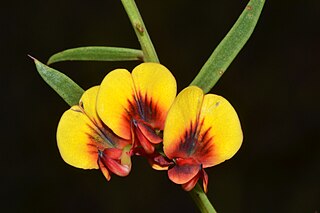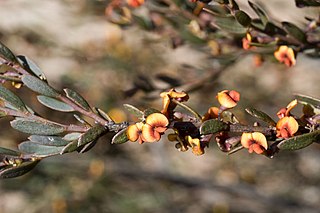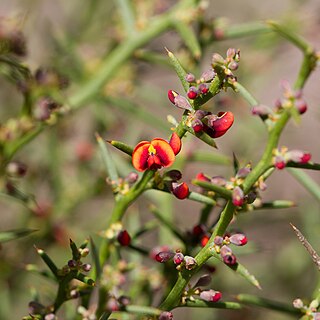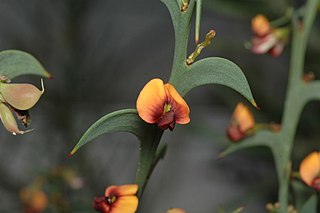
Daviesia divaricata, commonly known as marno, is a species of flowering plant in the family Fabaceae and is endemic to the south-west of Western Australia. It is a low, spreading or erect and bushy shrub with phyllodes reduced to small, triangular scales, and orange and maroon flowers.

Daviesia buxifolia, commonly known as box-leaf bitter-pea, is a species of flowering plant in the family Fabaceae and is endemic to south-eastern continental Australia. It is an open shrub with egg-shaped to round phyllodes and yellow or yellowish-orange and maroon-brown flowers.

Daviesia hakeoides is a species of flowering plant in the family Fabaceae and is endemic to the south-west of Western Australia. It is a shrub with many tangled stems, scattered sharply-pointed phyllodes and yellow or orange and dark red flowers.

Daviesia angulata is a species of flowering plant in the family Fabaceae and is endemic to the south-west of Western Australia. It is an erect, spreading shrub with prickly, flattened phyllodes, and yellow flowers with red markings.

Daviesia argillacea is a species of flowering plant in the family Fabaceae and is endemic to the south-west of Western Australia. It is an erect, bushy shrub with erect narrow egg-shaped phyllodes with the narrower end towards the base, and yellow to orange and maroon flowers.
Daviesia audax is a species of flowering plant in the family Fabaceae and is endemic to the south-west of Western Australia. It is an erect shrub with scattered, erect, thick, rigid, sharply pointed phyllodes, and orange flowers with reddish-brown markings.

Daviesia crassa is a species of flowering plant in the family Fabaceae and is endemic to the south-west of Western Australia. It is a compact, dense, glabrous shrub with densely crowded, thick, club-shaped phyllodes, and uniformly yellow flowers.

Daviesia debilior is a species of flowering plant in the family Fabaceae and is endemic to the south-west of Western Australia. It is a shrub with low-lying stems and many erect branchlets, scattered linear to scale-like phyllodes, and yellow, purplish, orange-pink and dark purplish flowers.

Daviesia decipiens is a species of flowering plant in the family Fabaceae and is endemic to the south-west of Western Australia. It is an intricately-branched shrub with scattered, sharply-pointed oblong or tapering phyllodes, and orange, maroon and crimson flowers.

Daviesia decurrens, commonly known as prickly bitter-pea, is a species of flowering plant in the family Fabaceae and is endemic to the south-west of Western Australia. It is spreading, erect, or low-lying shrub with scattered, sharply-pointed, narrow triangular phyllodes, and yellowish pink and velvety red flowers.

Daviesia aphylla is a species of flowering plant in the family Fabaceae and is endemic to the south-west of Western Australia. It is an erect, bushy shrub with glabrous foliage, up to six sharply-pointed phyllodes on each branchlet, and orange-red and yellow flowers.

Daviesia devito is a species of flowering plant in the family Fabaceae, endemic to south-eastern continental Australia. It is a dense, prickly shrub with sharply-pointed phyllodes and yellow, red, greenish and maroon flowers. It was previously known as Daviesia benthamii subsp. humilis until that subspecies was split into two new species.

Daviesia dilatata is a species of flowering plant in the family Fabaceae and is endemic to the south-west of Western Australia. It is an erect, open, glabrous shrub with scattered, often sickle-shaped phyllodes, and orange, red, yellow and dark crimson flowers.

Daviesia emarginata is a species of flowering plant in the family Fabaceae and is endemic to the south-west of Western Australia. It is an erect, mostly glabrous shrub with scattered egg-shaped phyllodes with the narrower end towards the base and with a notch at the tip, and yellow and pink flowers.
Daviesia eremaea is a species of flowering plant in the family Fabaceae and is endemic to central Australia. It is an erect, glabrous, multi-stemmed shrub with needle-like, more or less sharply-pointed phyllodes, and yellow and red flowers.

Daviesia euphorbioides, commonly known as Wongan cactus, is a species of flowering plant in the family Fabaceae and is endemic to a restricted area in the south-west of Western Australia. It is an open, erect to sprawling, cactus-like shrub with thick, fleshy branchlets and phyllodes reduced to scattered, sharply-pointed spines, and bright yellow, reddish-brown and maroon flowers.

Daviesia flexuosa is a species of flowering plant in the family Fabaceae and is endemic to the south-west coast of Western Australia. It is a glabrous, spreading shrub with zig-zagged branchlets, scattered, sharply-pointed, narrowly triangular phyllodes and yellow and red flowers.

Daviesia genistifolia, commonly known as broom bitter-pea, is a species of flowering plant in the family Fabaceae and is endemic to south-eastern continental Australia. It is a glabrous, low to open shrub with scattered, sharply-pointed, cylindrical phyllodes and yellow or orange-yellow, deep red and maroon flowers.

Daviesia glossosema, commonly known as maroon-flowered daviesia, is a species of flowering plant in the family Fabaceae and is endemic to a restricted area of south-western Western Australia. It is an erect shrub with tangled, spreading branches, cylindrical, sharply-pointed phyllodes, and unusually-shaped maroon flowers.

Daviesia gracilis is a species of flowering plant in the family Fabaceae and is endemic to the south-west of Western Australia. It is an open, spreading shrub with its phyllodes reduced to scales, and has orange-yellow and maroon flowers.



















